Name: Larry Curtis
Title: President and Managing Partner, WinnDevelopment
Age: 58
Experience: 34 years
WinnDevelopment has helped crack the code for how to build affordable housing in high-cost Greater Boston. Using historic and low-income tax credits, the Boston-based developer has rehabilitated dozens of aging buildings and vacant mills into multifamily complexes. Much of the strategy was overseen by its president, Larry Curtis, who marks his 30th year with the company this month. The chairman of a National Multifamily Housing Council affordability task force, Curtis has been promoting federal legislation creating a tax credit program to encourage the development of workforce housing for middle-income families.
Q: What was your first affordable project?
A: My first project was Brookside Estates in Andover, a 40B. MassHousing was beginning to recognize that zoning alone, which is what Chapter 40B is, didn’t create economic viability. Even today, in most communities in Massachusetts, you could hand out building permits and free land and say “build affordable housing,” and it doesn’t work without a subsidy. So MassHousing did a program at the time, it was called the State Housing Assistance Rental Program (SHARP). It provided a subsidy for about 60 40B projects around the state. They were done as 75 percent market, 25 percent affordable. The higher-end communities like Andover didn’t look at it as, “Those people are coming in.” And Brookside was a success.
Q: You mentioned in a speech that you became interested in the building industry when you were 12. Do you have family with background in real estate?
A: My dad was a real estate lawyer, doing relatively simple house closings in suburban New York. My father’s principal client was a builder and we went to a Christmas party at his house when I was a kid. I said, “I want to do what he does.” He lived in the big house up on the hill. I bought my first building when I was 18 in Amityville, New York. I bought a house for $17,000 and fixed it up and sold it for $34,000 and I said, “This is pretty good.”
Q: What’s the latest on Lowell’s redevelopment plans for the Hamilton Canal District?
A: We responded to the city’s request for proposals and told the city what we wanted to do, a couple of housing deals. The city approved us. We were the only respondent. And then the city changed its requirements, looking for more commercial development. We thought our plan made sense, and said, “Hey, call us back when you have your overall plan together.” We’re still interested. We think we’re the logical developer. We’ve probably done more in Lowell than anybody, but it’s turned out to be not an immediately viable opportunity. Among nine councilors, they have 11 opinions what should happen. They put forth an RFP that had specific criteria. We said, “We’ll do what you want us to do.” Then they decided that’s not what they really want.
Q: What’s been the most effective subsidy for affordable housing?
A: The principal drivers have been the low-income credit that’s been around since 1986 and the historic credit that’s been around since 1982. I don’t think it’s a coincidental that’s basically the tenure of my career. Those programs do an excellent job serving people and families with 60 percent or less of the median income. In Boston, that’s people making less than $48,000 a year.
What I’ve been focused on in recent years in addition to affordable is how to serve the workforce housing. How do you build housing for that? When you’re building ground up, it’s very difficult. There’s a misperception that developers build luxury housing because they can make more money than middle-income housing. The reality is you can’t build a building and rent it to somebody that can pay $1,300 a month. The math doesn’t work. What I’m trying to do at a national level is create a middle-income tax credit. How do people with good paychecks live in (high-cost areas)? We’re hoping in the new administration there’s some legs to it.
Q: Where are we in the multifamily cycle now in Massachusetts?
A: In affordable housing and existing apartment buildings that were built 30 or 40 years ago, there’s great investment fundamentals and demographics. We’re a big buyer and a big believer in apartment buildings, not just in Greater Boston. The barrier to build in Medford, or Winchester or Woburn, you can buy an apartment building for far less than it costs to build anew. On the luxury end, there’s obviously a lot of new product being built, lots of concessions: two or three months free rent. I don’t know where the dollars are going to come to fill all of these units. You see rents that are $5,000, $6,000 a month.
Q: Why do developers offer free rent promotions rather than lowering rents across the board?
A: They lock into an underwriting that says, “My rent is this.” And they base their whole equity and debt analysis on that as they seek capital to get the project built. They build into the capital reserve this free rent component that they hope is non-recurring just to get people into the property. If at the time of renewal, the tenant moves on to the next deal that’s being offered, it’s not really the economic rent. There’s a little bit of gamesmanship going on.
Q: How will the passage of the Community Preservation Act in Boston affect housing production?
A: More resources for affordable housing are good. The CPA allows for affordable housing, open space and historic development. The incremental dollars I’ve seen are $20 million to $25 million a year. We hope the committee that distributes the money puts forth a significant portion of the money to housing. It’s not going to solve the problem. To build affordable housing in Boston is $400,000 a unit of total development cost. So if you do the math, it doesn’t add up to much.
Five Books Curtis Has Read Recently:
- “Red Notice,” by Bill Browder
- “American Pastoral,” by Philip Roth
- “Mapping History,” by Jeremy Black
- “Kissinger,” by Niall Ferguson
- “Rebuilding the American City,” by David Gamble




 |
| 


